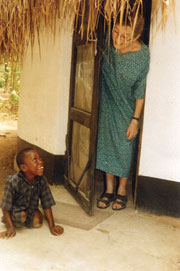Wonders of mission
By Sr. Rosemarie Donovan, O.L.M.
March/April 2009
Return to Table of Contents
Print Article
Sampson is the lad from our Nigeria mission who graced Our Lady’s Missionaries’ 2008 calendar. Last year, he had corrective surgery on both legs, his father believing he could one day walk on his own. The operation would help Sampson to make better use of his callipers, boots, and crutches. He returned to St. Joseph’s Centre to have his new leg braces and boots constructed. Our welder, who is also disabled, measured him, bending and manipulating the joints. Sampson, usually full of laughter and mischief, sobbed and cried out loudly, “Why do I have to suffer so much, I am just little.”
At the age of 79 and no longer little, I understand and accept my own suffering with bouts of loneliness these past seven months. It is connected with Sampson, with my Sisters in Vandeikya, and with all the valiant and treasured friends I left behind when I returned to Canada because of illness. There will be no return; no hugs; no goodbyes, but there will always be a deep gratitude to God for gifting me with 32 fulfilling, happy years in Nigeria.
I am now sharing with many of our Sisters here in Canada the pain of transition—so different for each one. There is a sameness however, as we contemplate the wonders of mission opened to us by our founder Fr. Dan Macdonald in the countless opportunities afforded us to work with God’s poor and forgotten ones in various parts of the world. And we thank you, our families and faithful friends who have believed in us and supported us in our call to mission these past 60 years.
For how are we to proclaim Jesus unless we are sent? And how without being sent were we ever to discover that all too frequently it is the poor and oppressed who show us the resurrection? They are indeed the Good News for us.
Return to Table of Contents
Print Article
